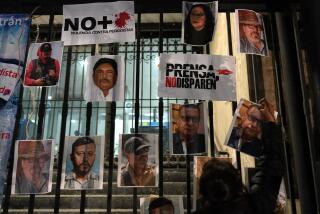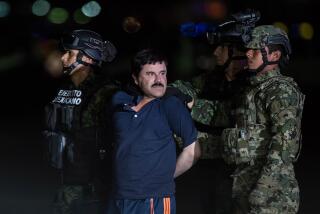Mexico news companies agree to drug war coverage guidelines
- Share via
Reporting from Mexico City — Many of Mexico’s top media companies agreed Thursday on first-ever guidelines for covering a drug war that has drastically increased risks for journalists.
The 10-point accord, covering more than 700 outlets across the country, calls on news-gathering organizations to find ways to protect their journalists and avoid glorifying crime bosses.
The guidelines also urge news organizations to unite against threats to journalists, such as by jointly publishing stories. Under the agreement, the companies should draw up standards for showing violent images, such as decapitated bodies, and provide more context when reporting on drug violence.
Mexico’s drug war, launched by President Felipe Calderon in late 2006, has put Mexican news organizations in a tough spot: They have been attacked or threatened by drug gangs and also accused by the government and others of sensationalizing carnage that has killed more than 35,000 people.
“The media have a responsibility to act with professionalism and question ourselves about the potential implications of how news is handled,” the six-page agreement says.
But written guidelines may do little practical good in zones such as the northern state of Tamaulipas, where drug gangs have already in effect muzzled news organizations, leaving residents in the dark about the violence raging around them. Many people in these places rely on social networks, such as Twitter, to trade information on street shootouts and other incidents.
More than 30 journalists have been killed or have disappeared in Mexico since Calderon began the crackdown, according to the New York-based Committee to Protect Journalists.
Several outlets declined to sign, including the daily newspapers Reforma and La Jornada, and Proceso, a muckraking weekly magazine.
Jenaro Villamil, a writer at Proceso, said in a radio interview that the agreement opened the door to censorship and marked an effort by media giants to control public opinion amid growing alarm over the country’s drug violence.
Supporters, including the biggest television networks, Televisa and TV Azteca, and many radio and newspaper companies, denied that the pact amounted to a form of self-censorship.
Calderon applauded the agreement, calling it an expression of “social responsibility” by news companies in Mexico.
Critics have accused the news media of stoking broad fear through daily coverage of the drug war that often includes gruesome images that would never be published by mainstream outlets in the United States.
Many Mexicans fear that the sustained exposure is making their society numb to the savage violence, even though it reflects the grim reality that exists in many places.
The agreement says news organizations should not serve crime groups’ “terror strategies” by portraying traffickers as heroes or publishing their propaganda, such as the so-called narco-banners that are often posted by cartels and frequently shown on television or in newspaper photographs. The guidelines also call on media not to treat suspects as guilty before trial.
Many reporters in Mexico refuse to add their names to stories to avoid reprisals. Journalists in violence-torn Colombia sought to shield themselves from cartel reprisals by jointly publishing articles, an idea borrowed by the Mexican accord.
More to Read
Sign up for Essential California
The most important California stories and recommendations in your inbox every morning.
You may occasionally receive promotional content from the Los Angeles Times.










